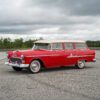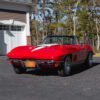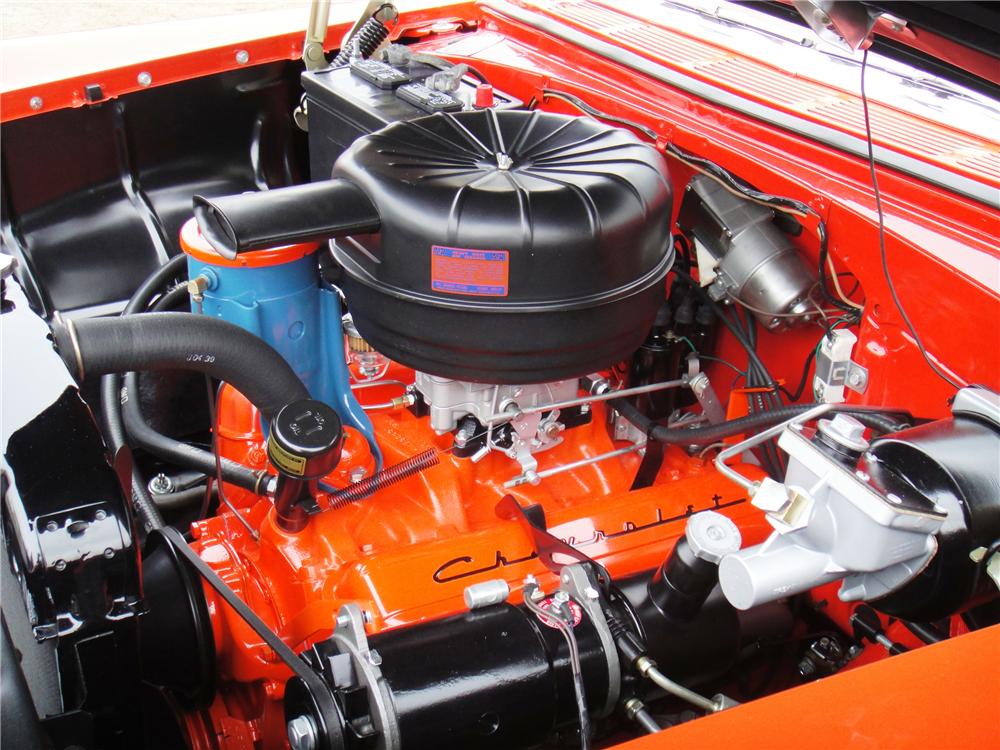Chevy Small Block V8
Generation I – 1955-2003
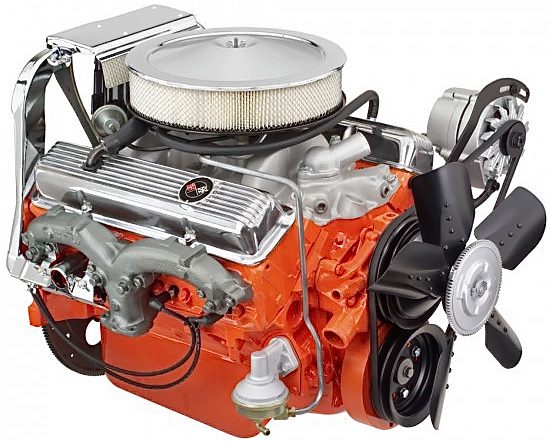
Chevy Small Block V8 Background
From its introduction in 1929, the stovebolt six was Chevrolet’s only engine, in every car and truck they built, until 1954. Ford had launched its legendary Flathead V8 in 1932 and by 1954 was already replacing it with the OHV Y-block V8. Across town, Chrysler debuted their first Hemi V8 in 1951. Chevy’s own sister divisions, Oldsmobile and Cadillac both got modern OHV high compression V8s in the late 1940s. Coming into the 1950s, Chevy needed a V8!
Chevy Small Block V8-a stroke of genius
Chevy chief engineer Ed Cole, who would later become President of GM, designed the new Small Block V8 to be compact, lightweight, cheap to produce, and to incorporate all the latest engine technologies. This included the new stud-and-ball style stamped-steel rocker arm design that had just been patented by Pontiac, who planned to introduce it in their own 1955 models. GM had an internal policy to allow each division to benefit by their own patents for two years before sharing them with the other GM divisions. However, GM brass changed the rules in this case allowing the new engine to eschew the use of complex rocker arm shafts. The new engine was also heavy oversquare (big bore – short stroke), with 4.4-inch bore centers and a deck height of 9.025 inches, dimensions that are common to all Chevy small block V8s, right up to those built today. The intake manifold formed the sealed top cover for the engine valley (lifter gallery) where typical practice at the time was for the valley sealed off by a separate cover from the manifold. Everything on Cole’s design was meant to cut down the weight, bulk, complexity, parts count, and assembly time. The oil pump was mounted to the rear main journal, and drove that now-famous rear-mounted distributor that was a trademark of the Chevy Small Block V8, at least back in the day when engines had distributors. The one thing it didn’t have at its 1955 release, was an oil filter. An optional external unit was made available for the 1955 model year, and by 1956, an oil filter boss was cast into the block.
The Introduction of the Chevy Small Block V8
Chevy’s new small block V8 was introduced in the 1955 Corvette and Bel Air with 265 cubic inches of displacement. They gave it the very 50’s-sounding name “Turbo-Fire V8”, and it put the Corvette on the map. Until now, the ‘Vette was powered by the lowly stovebolt-six, in “Blue Flame Six” trim. The new 265 had a 3.75-inch bore and a 3-inch stroke, was available with up to 195 horsepower, and it totally transformed the car. It was available in a variety of configurations in its first few years, including single 2-barrel, single 4-barrels with 180- or 195-horsepower, a 225-horse 264 with two 4-barrels, and a 240-horse motor with two 4-barrels and a high lift cam. Of course, this was just the beginning.
Chevy Small Block V8: “the Mouse Motor”
At the time, there was a Saturday morning cartoon on TV called “Mighty Mouse”, a tiny mouse with the power of Superman. Someone saw similar qualities in Chevy’s diminutive new engine and called it “Mighty Mouse”. The name stuck. Then in 1959, a movie came out called “The Mouse that Roared”, further adding to the mix. It wasn’t long before racers and hot rodders alike dropped the first part and just started calling it the “Mouse”, or the “Mouse Motor”. To this day, it’s still called the Mouse Motor. An interesting development to the story came in 1965 when Chevy released it’s new Big Block 396 V8. If the Chevy small block was called “The Mouse”, then the new big block must be “The Rat”. And that name stuck also. So today, big blocks are known as “Rat Motors”, or just “Rat”. Common back in the 1970s was to hear someone refer to their engine as a ‘454 Rat’. All this engine-naming has its roots with the Chevy small block V8 and a little cartoon mouse with super strength.
265 Cubic Inch (4.3-Liter) V8, 1955-1957
The 265 cid V8 was Chevy’s first Small Block V8. It had a 3.75-inch bore and a 3.00-inch stroke, a stroke that it would share with the upcoming 283, and the wicked DZ302 that would power the first Z/28 Chevy. When first introduced for the 1955 model year, no accommodation was made for a built-in oil filter on the block. And many 265s left the factory in both Corvettes and Bel Airs without any sort of oil filtration. Bad idea. Chevy quickly offered a dealer-installed kit that mounted a rather unsightly oil filter canister vertically right above the thermostat housing on the front of the engine, with external plumbing. They had solved this oversight by the 1956 model year by casting an oil filter boss into right-rear of the cast iron block. The 265 was available in several configurations, all revolving around its carburation scheme. The single 2-barrel version made 162 horsepower; two single 4-barrels engines, one with 180- and one with 195-horsepower; then the ‘big-gun engines’, a pair of twin 4-barrel engines, one with 224 hp and the other with 240, thanks to a high-lift cam. In their final year of production, 1957, one could order either the 265 or the new-for-1957 283. Obviously the 265 had just been made redundant and obsolete.
BELOW: This 1956 Corvette has a 265 V8 with two 4-barrels on an aluminum intake manifold, all from the factory. Depending on the cam used, this could be either a 224hp or 240hp engine.

283 Cubic Inch (4.6-Liter) V8, 1957-1967
The 283 started with the 265’s 3.00-inch stroke, then added 1/8-inch of bore, from 3.75- to 3.875-inches to make the new 283 cubes, while pushing it even farther oversquare (bigger bore relative to the stroke), which tends to make engines produce more of their power at higher RPMs. Old school engines that were designed prior to this latest wave of modern OHV V8s generally had long strokes relative to their small bores (undersquare), which made them slower-revving and torquier. The trend was moving toward heavily oversquare engines with higher compression, like the 283. Early 1957-model year engines used the same block castings as the 265 and simply bored them out farther. But this was found to leave some blocks with thin spots and and overheating was a problem. So, a new block casting was made partway through 1957 that thickened the cylinder sleeve area. Good thing too, because a new wave of performance upgrades were added, all the way up to Rochester mechanical fuel injection good for 283 horsepower. This made the Chevy Small Block V8 the world’s first mass-market engine to produce that magic number: one horsepower-per-cubic inch. Today, cars make 100+ horsepower from one-liter (about 61 cubic inches) routinely with normal aspiration. But back in 1957, 1 HP/ cid was stellar! By 1961, the output of the fuel-injected 283 climbed to 315 horses. The 283 Chevy small block V8 stayed in production from 1957 through 1967, and became Chevy’s entry-level V8 for its midsized cars, and the go-to engine for its small car lineup. As such, the 283 was always available in several different configurations and horsepower ratings.
BELOW: This C1 Corvette has a 283 with the Rochester Ramjet mechanical fuel injection, good for 315 horsepower by 1962.
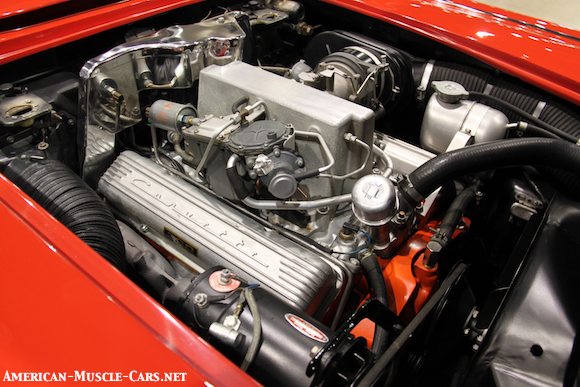
327 Cubic Inch (5.4-Liter) V8, 1962-1969
There’s no replacement for displacement. By the dawn of the 1960s, there was a serious horsepower war brewing between the Big 3, and Chevy wasn’t about to be left behind. Adding cubic inches to the small block V8 turned out to be pretty easy. With generous 4.4-inch bore centers, they were free to bore it well over 4.00-inches, and there was plenty of room to expand the stroke as needed. For the 327, the bore was an even 4.00-inches, with a 3.25-inch stroke. Chevy recast the block to handle the bigger bore and increased torque output. When introduced in 1962, the 327 small block V8 was available in several configurations and outputs, from 210hp in 2-barrel form all the way to 375hp with the Rochester fuel injection system, well over the time-honored one-horsepower-per-cubic-inch standard set by the 283 back in 1957. Through a combination of fuel systems (carburetor or fuel injection), cams, heads and compression ratios, Chevy was able to craft a wide range of outputs. When introduced in 1962, the top rated non-fuelie 327 had 340hp and was an amalgam of a Duntov solid lifter cam and a single Carter 4-barrel. With fuel injection, the same engine made 360hp, 365hp by 1964 (L76), and 375hp in its final year 1965 (L84). At 375hp and 327cid, the 1965 version had the highest specific output of any normally aspirated, OHV small block V8 until the Gen III LS6 came out in 2001. The Chevy 327 small block V8 remained in service through the 1969 model year in a variety of forms. It was slowly replaced by the 350 V8, which was introduced in 1967. By 1970, both the venerable 283 and the 327 were gone, replaced by the 307 and the 350 respectively.
BELOW: This ’65 Corvette carries the last fuel-injected 327 Chevy would build. It has the ‘big’ Rochester Ramjet mechanical fuel injection system, decidedly bigger than the one used on the 283. In this form, and in 1965, the 327 “Fuelie” made 375 horsepower. That’s screamin’ back in 1965! I actually had one of these engines in my ’55 Nomad back in the early 70s, and was near-unbeatable on the street.
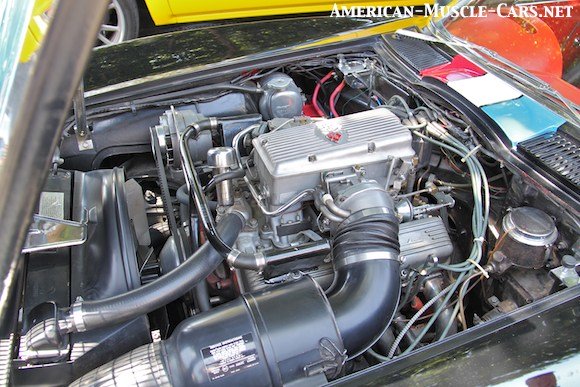
DZ302- 302 Cubic Inch (4.9-Liter) V8, 1967-1969
By the mid-1960s, the SCCA (Sports Car Club of America) Trans Am racing series was red hot, and raced cars very much like the ones buyers could see in the showrooms, unlike the exotic machines racing in Formula 1 and the like. So it was good for business (“Race on Sunday, sell on Monday”). However, SCCA limited engine displacement to exactly 5.0-liters (305.1 cubic inches). Other than the diminutive 283, Chevy didn’t have the right-sized engine. Across town, Ford was working on their Boss 302 and Chrysler was busy taking displacement out of their LA-small block 318, for the cars that would become the Dodge Challenger T/A and Plymouth Cuda AAR. To counter this, Chevy took a 327 block (with 4.00-inch bore), and dropped in a 283 crankshaft (with 3.00-inch bore) and voila’ the DZ302 was born. And with this highly oversquare ratio, the engine loved to rev. Because of this, everything inside was beefed up. Large-journal forged steel crank, big connecting rod bolts, thicker webbing in the block, and starting in 1968 four-bolt main bearing caps (the center three, anyway), with thicker bulkheads. Zora Arkus-Duntov (the father of the Corvette) was heavily involved in the 302’s development for racing, hence the engine’s name “DZ302”. It stands for “Duntov, Zora”. The 302 crankshaft was tufftride-hardened and forged from 1053-steel, with a windage tray. The connecting rods were heat-treated, magnafulxed, and shot-peened after being forged out of 1038-steel and were known as ‘pink’ connecting rods. Starting in 1969, the forged-aluminum pistons got full-floating wrist pins. Duntov was a genius at designing cams, and for the DZ302, it was the solid-lifter “30-30 Duntov” cam, so called because of its .030-inch valve clearance (lash) intake and exhaust. The cylinder heads were the biggest they had for the 327, with 2.02-inch intake valves, known by the nickname “Fuelie Heads” or simply “Fuelies” because they’d been used with the Rochester fuel-injected 327 in the Corvette through 1965. They were also known by the double-humped casting flashes on each end of the head castings. They had the look of a camel, so racers were soon calling the “Camelback heads” or “double-hump heads”. Earlier “Fuelie” heads had 1.94-inch intake valves. But the larger 2.02s were obviously desirable for their better flow, although some experience cracking in the narrow area between the valves. An aluminum high-rise intake manifold was fitted with a Holley 780cfm 4-barrel carburetor with vacuum secondaries. The single-point distributor had a specially-designed points cam to prevent high-RPM points-bounce. A breaker-less transistorized ignition system was optional. The high-RPM potential of this engine required a special harmonic balance, and all the engine pulleys had deeper grooves than normal to give the belts better bite. The DZ302 was topped off with a chromed air cleaner, and finned aluminum valve covers from the LT1 350. These engines came from the factory with 11.0:1 compression, hard to do back in the bad ol’ pre-computer days. It was conservatively rated at 290-horsepower at 5800 rpm, but it actually made more like 376 horses. It came with a close-ratio M22 Muncie 4-speed, and a variety of rear-end ratios, all with posi-traction, all the way down to 4.88:1 drag gears, that allowed it to storm the quarter-mile in 12.9-seconds at 108 mhp, scorching numbers in 1969. 1967 Z28 buyers got a set of factory headers in the trunk! Show cool is that? Alas the mighty DZ302 was with us just three short model years. When the Camaro went through its generational change in 1970, they replaced the DZ302 with the LT1 350, another sweet Chevy small block V8, that liked to rev like the 302, but had the low-end torque that the 302 lacked.
BELOW: The ultimate Mighty Mouse, this 302 packed a lot of power, up high on the rev band. Note the cold air set up. This one’s in a 1969 Camaro Z/28, and was conservatively rated at 290hp.

350 Cubic Inch (5.7-Liter) V8, 1967-2003
Bigger is always better in the car biz, at least it was in the 1960s, when everyone was upsizing their engines. Ford’s small block V8 had just been punched out from 289 to 302 cid. Across town at Chrysler, they’d just turned their LA small block V8 from a 273 to a 318 and a 340. Even GM’s stablemates were doing it. Pontiac turned its 326 V8 into a 350, and the rest were busy boring and/or stroking their engines out. Chevy stroked the 327 to 3.48-inches, leaving the 4.00-inch bore alone, creating an even 350 cubic inches of displacement. From here, it gets complicated, because the Chevy 350 small block V8 is one of the most-produced engines in history, with so many variants that they need to be broken down to be fully examined. Below is a breakdown of the various 350 engine configurations that are of interest to us (muscle car nuts). However, 350 V8s have been in just about every mode of transportation at one time or another, sometimes in high performance applications, and sometimes doing very lowly work like running generators. Camaro fans are proud of the fact that the Chevy 350 small block V8 made its debut in a Camaro, the 1967 Camaro SS.
L46 350 V8, 1969-1970
The L46 was an optional high-performance engine on Corvettes for two model years only. Identified by the casting number 186, the L46 came with 4-bolt mains, “fuelie heads” with 2.02-inch intake valves and 1.60 exhaust valves, 11:1 compression ratio and making 350hp. It came with a Rochester Quadrajet 4-barrel and a hydraulic cam.
L48 350 V8, 1967-1980
This was literally the first 350 V8 Chevy produced, which debuted in the 1967 Camaro SS, exclusive to that car for the 1967 model year. By 1968, the 350 had spread through the entire Chevrolet passenger car and truck lineup. Internally, the L48 used cast pistons, a hydraulic cam, 4-bolt mains and a 10.25:1 compression ratio. With Rochester Q-jet carb it made an even 300 horsepower and 380 lb/ft of torque…at first. But by the 1971 model year, tightening federal regulations on emissions and fuel economy, plus the removal of lead from the fuel, forced GM to drop compression on all its engines across the board. In 1971, the compression ratio of the L48 dropped from 10.25:1 down to 8.5:1. By 1975, the hottest L48 you could get was in the Corvette, now making a wheezing 165hp. It was so bad that Chevy was too embarrassed to field a Z28 version of the Camaro for 1975. However, 1975 was the low-point, after which GM began figuring out ways to get more performance out of their engines while conforming to ever more stringent government mandates. By 1976, horsepower for the L48 had climbed to 180, and 185 by 1978 (except California, which had to settle for 175hp). Then in 1979, it climbed again 195hp, dropping slightly to 190hp for the 1980 model year, it’s final year in production.
ZQ3 350 V8, 1969-1974
The ZQ3 was the standard engine in 1969 to 1974 Corvette. It started out with 10.25:1 compression, a Rochester Q-jet carb and 300-horsepower. Federal regs forced a drop in compression for the 1971 model year to 8.5:1, lowering horsepower to 270. And this was just the beginning. 1972 saw horsepower dip to just 200, and in 1973 in dropped again to 190. It went up slightly in 1974 to 195 horsepower, it’s final year.
LM1 350 V8, -1970-1988
The LM1 was the base 4-barrel 350 V8 in Chevy passenger cars and trucks throughout the 1970s and most of the 1980s. Carrying a Rochester Q-jet carburetor, the LM1 made a middling 155 to 175-horsepower, depending on year. They were optional in Chevy passenger cars until 1979, and in the Camaro Z28 until 1981, it’s last use in a retail passenger car. After that, they were only used in Police Interceptors until 1988. By this time, GM had mandated no V8 larger than 5.0-Liters, with the exception of their performance cars (Corvette, Camaro and Pontiac Firebird & Trans Am. So, the 350 cid LM1 was made obsolete, and replaced by the LO5 350 V8 starting in 1988.
L65 350 V8, 1970-1976
The L65 was the 2-barrel version of the LM1, above, rated at 145 hp.
LT-1 (Gen I) 350 V8, 1970-1972
While the LT-1 name has been used three times now for Chevy engines, 1970 was the first. At the time, it was considered the ultimate Chevy small block V8, and was only available in the Corvette and the new-for-1970 2nd-gen Camaro Z28. With a wild solid-lifter cam, 11.0:1 compression, Delco transistorized ignition, LT-1-specific aluminum intake manifold, Holley 780cfm 4-barrel and high-flow, low-restriction ‘rams horn’ exhaust manifolds, it made 370hp in the Corvette and 360 in the Z28 (due to more restrictive exhaust, reportedly, although Chevy was always reluctant to allow the Camaro to match the Corvette’s max output). Both versions made 380 pound-feet of torque at 4,000 rpm. This was a free-revving engine which redlined at 6500 rpm, although the power dropped off after about 6200. Of course, 1970 was the peak of performance in this era, with compression and output dropping severely starting in 1971, due to no-lead gas, Federal smog regs and fuel economy mandates, not to mention pressure from the insurance companies. Times were tough for muscle cars. In 1971, the LT-1 dropped to 330 gross hp. 1971-72 were the years when Detroit started quoting “Net Horsepower” instead of “Gross Horsepower”. The reason that was given was to be more honest with the consumer, that net hp was more realistic. Perhaps they were simply reacting to the pressure from soaring insurance prices for performance cars. It was eating into their muscle car business, and showing lower horsepower numbers would look better to insurance companies, offering lower rates to the car buyer. The Net hp was now 255, with 360 lb/ft of torque due in large part to its lowly 9.0:1 compression ratio, done to allow the running of low-octane no-lead gasoline. Higher compression engines pinged (pre-detonation) with the new gas.
BELOW: This 1970 Z/28 has the red-hot LT-1, considered by many to be the pinnacle of carbureted 350s.
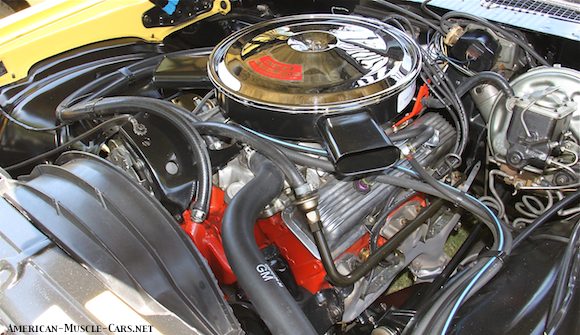
L82 350 V8, 1973-1980
The L82 was the hottest 350 Chevy offered from 1973 to 1980. It had the good heads, 2.02-inch intake valves with 76cc combustion chambers and a Rochester Quadra-jet 4-barrel sitting on top of a split-plenum aluminum intake manifold. The same finned aluminum valve covers used on the 1970-72 LT-1, but with a crinkle-black finish With 9.0:1 compression, forged aluminum pistons and an aggressive hydraulic cam, the L82 made 250 hp (SAE net), and 285 pound-feet of torque, in its maiden year. By 1975, it was down to 205hp and 255 lb/ft, it was a low point, as it turned out. Improving technologies were being developed at GM to derive more power while satisfying all the government-mandated emissions and fuel regs. In 1976-77 got a slight bump to 210hp, another in 1978 to 220hp, in 1979 to 225hp, and in 1980, the L82’s final year, it hit 230hp. The L82 was only available in the Corvette and Camaro Z28s.
L81 350 V8, 1981
The L81 was the only 350 (5.7L) engine available in the 1981 Corvette. With its weak 8.2:1 compression ration, it made a whopping 190hp and 280 lb/ft of torque, which happens to be the exact same output rating as the L48. However, the L81 hadded a hotter cam and computer-controlled spark advance. The L81 also has the distinction of the being the only Corvette engine to use a “Smart Carb”, essentially a modified Q-jet with electronic mixture control run by an ECM (Engine Control Module, ie: a computer) that read data from an oxygen sensor in the exhaust stream. These early electro-mechanical fuel systems were a nightmare, tricky to tune and keep tuned, trying to do all the things that modern computerized fuel injection does, but with a primitive carburetor.
L83 350 V8 w/”Cross-Fire Injection”, 1982 & 1984
The L83 was again the only engine available in the last year for the C3 (3rd-generation) Corvette in 1982. Then, because of delays in launching the radically-new C4, the entire 1983 Corvette model year was skipped (there are no 1983 Corvettes, other than a prototype), and when the new 4th-gen Corvette was unveiled in 1984, the only engine available, again, was the L83. This engine took what the L81 had, and replaced the carburetor with a twin-throttle body fuel injection system Chevy named “Cross-Fire Injection”. It was so named because the two throttle bodies were offset side-by-side, each feeding the opposite cylinder bank through a manifold that resembled the old ‘Cross-Ram’ manifolds from the 50s and 60s. Cool name, great look, but just middling performance. These early fuel injected engines struggled to make 200hp and 285 lb/ft in 1982, and 205hp and 290 lb/ft in 1984. The were also difficult to tune, and often ran soft. They also had a tendency to idle fast. Cross-Fire Injection was replaced in 1985 by Chevy’s radical new Tuned Port Injection system (TPI), which worked extremely well. The technology had finally arrived.
BELOW: The Cross-Fire Injection gave the venerable old 350 a whole new look, in perfect keeping with the radical looks of the new C4 1984 Corvette.
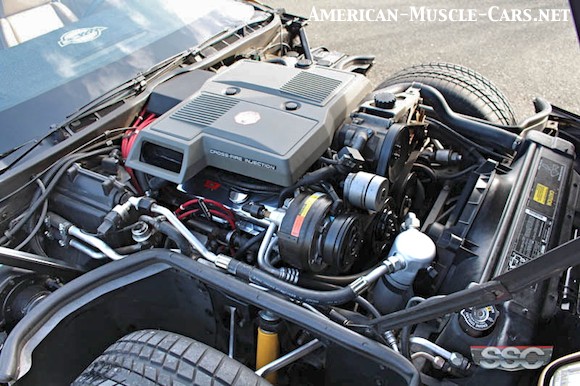
L98 350 V8 w/Tuned Port Injection (TPI), 1985-1992
The Cross-Fire Injected 350 was replaced with the new 5.7L (350cid) Tuned-Port Injection (TPI) V8, and became the standard engine in the Corvette from 1985 through 1991. TPI was the most advanced fuel injection system GM had ever produced on a V8. It used a variety of sensors and controller to meter fuel through sequential port injectors, all controlled by the ECM (Engine Control Module, ie: computer). When the L98 was released in 1985, it had cast iron heads. Partway through the 1986 model year, these were replaced with aluminum heads. Horsepower was rated at 230 for 1985-86, 240hp for 1987-89, and 245hp for 1990-91. The optional performance axle ratio of 3.08:1 included a 5hp bump starting in 1988. The aluminum heads gained D-ports in 1987, and a new hydraulic camshaft with roller lifters was adopted to reduce friction. Starting in 1987, the L98 became available on the Camaro Z/28 and IROC-Z, and the Pontiac Firebird and Trans Am, but with iron heads. There it was rated at 230hp with standard single-catalytic converter 2-into-1-into-2 exhaust system. But with the optional G92 package, it came with a freer-flowing dual-cat exhaust system that bumped it up to 245hp, the same as that of the Corvette. In the Camaro it was only available with the 700R4 automatic transmission. GM did not have a 5-speed manual gearbox in its inventory that could handle the torque of the might 5.7 TPI engine. If you wanted a 5-speed in your IROC or T/A, you had to settle for the 5.0 TPI (305cid). Compression ratio was 9.5:1 in the Camaro/Firebird and 10:1 in the Corvette, although both were rated at the same output.
BELOW: The 5.7L TPI (Tuned Port Injection) V8 in this 1991 Camaro Z/28. By 1991, Chevy had dropped the IROC-name and gone back to Z/28 as its top Camaro.

L05 5.7L V8, 1987-1996
Introduced in 1987, the L05 was used primarily in Chevy, GMC and Hummer trucks and SUVs, but also saw duty in the 1989-93 Chevy Caprice with the 9C1 police package. In this application, the L05 had a roller cam. In all others, it had a conventional flat-tappet cam. It also served as the standard or optional engine in full-sized GM cars from Buick, Cadillac and Oldsmobile. The L05 left production in 1996.
L31 Vortec 5700 V8, 1996-2002 The L31 was the last Generation I Chevy small block V8 to be produced, and it was intended for truck and SUV use across Chevy, GMC and Cadillac products. The new nomenclature abandoned the old cubic inch designations, and adopted the “Vortec” name. The engine used cylinder heads with ports and chambers similar to the Gen II LT-1, but without the benefits of reverse-flow cooling, a major feature of the new Gen II small block. This makes the L31 heads compatible with most other Gen I small blocks, which is a popular upgrade (requiring the use of the Vortec intake manifold). The Vortec engine uses 4 bolts per side to secure the intake manifold to the head, while earlier small blocks had 6 bolts per side. The L31 Vortec 5700 made from 255hp to 350hp at a leisurely 4600 RPMs, depending on tune and application, and 330 lb/ft to 350 lb/ft of torque at 2800 rpm, perfect for truck use. It was replaced in the 2003 model year by the new Gen II 5.3L Vortec 5300 LM7, ending the incredible run of the Gen I Chevy small block V8 that began in 1955.
307 Cubic Inch (5.0-Liter) V8, 1968-1973
The wickedly-fast DZ302 Chevy small block V8 was made by putting a 283 crank (3.00inch stroke) in a 327 block (4.00-inch bore). The 307 small block was made by doing just the opposite. They used the 283 block with its 3.875-inch bore, and the 327 crank with a 3.25-inch stroke. They both arrived close to the same displacement number. Yet two engines couldn’t be more different. The 302 was a rev-happy screamer that responded to performance modifications with gusto. The 307 is a dog, has always been a dog, doesn’t like to rev, and it doesn’t seem to matter what you do to them, they’re still not very fast. This was Chevy’s ‘smog-engine’ at the time. They wanted to discourage hooliganism. Not much here to talk about. When the 283 went away in 1967, a new entry-level V8 was needed for mundane passenger car duty and that was the 307. Never meant to go fast, just mean to go. The 307 shared some design and components with the 230 cid six-cylinder and the 153 four-cylinder. How’s that for humber roots? Not easy to do when your part of the Chevy Small Block V8 Family.
400 Cubic Inch (6.6-Liter) V8, 1970-1980
Gen I Chevy small block V8s were grouped into families based on their cylinder bores. The tiny 265 was the only one with a 3.75-inch bore. But the 283 shared its 3.875-inch bore with the 307. The 4.00-inch bore family included the DZ302, the 327 and the 350. To make a 400 cubic-inch V8 out of the Chevy Small Block V8, Chevy bored the iron block out to 4.125-inches, making it unique among Chevy small blocks, and thus the only one in this bore group. It also took lengthening the stroke from the 350’s 3.48-inches to 3.75 inches for the new 400. That seemed like a big stretch back in 1970. Even backyard tuners hadn’t taken the small block that far. Of course, today Chevy has taken the modern small block V8 all the way out to 427 cubic inches (7.0 liters), so there just seems to be no end to what they can do with this engine design. Because the bores were so large, the 400 block was made differently than any Gen I small block before in that it’s cylinders were ‘siamesed’ (joined together in the block casting, with no space in between them, within the water jacket). So steam holes had to be drilled in the block, head and head gasket to alleviate hot spots above the siamesed areas. Their larger 2.65-inch main bearing journals and 2.10-inch rod journals are unique to the 400. 1970-72 400 V8s got 4-bolt mains, but went to 2-bolt mains from 1973 on. Never intended as a performance engine, the 400 usually came with a 2-barrel carburetor and made 245-265 hp, but gobs of torque, up to 400 pound-feet. It was used primarily in Chevy and GMC trucks, although it was used in Chevy midsize A-body, and fullsize B-body cars until 1976.
305 CUBIC INCH (5.0-LITER) V8, 1976-1998
The 305 was intended as ‘the economy V8’ at a time of gas embargoes, rising fuel prices, CAFE and tightening emissions regs. It shared the 3.48-inch stroke of the 350 V8, but had a bore of 3.736 inches, unique among Chevy small block V8s. With better fuel economy than the 350, yet with better power and torque than GMs six-cylinders at the time, the 305 quickly spread across GMs entire stable of brands, in both cars and trucks. It even made a one-year appearance in a Corvette in 1980. It started out with a 2- or 4-barrel carburetor, with a “High Output 5.0L” version making 150-195hp (L69). The 305 upgraded to Throttle-Body Injection (TBI) in 1988. It was also available with Tuned-Port Injection (TPI) from 1985 through 1992 (LB9) in the Camaro Z/28, Firebird and Trans Am, making 215hp with single-catalytic converter exhaust system, or 230hp with optional G92 dual-cat system. Unlike the 5.7 TPI which was only available with the 700R4 automatic, the 5.0 TPI (305) could be ordered with either the auto or a 5-speed manual.
LG3 305 V8, 1976-1980
This was the 2-barrel ‘economy’-version of the early 305. It used a Rochester 2GC until 1978, then switched over to the more fuel-efficient Rochester Dual-Jet 2bbl in 1979. While mileage may have improved, horsepower dropped to 130hp, or if you were lucky enough to live in California, 125hp. Compression ratio was 8.5:1 for all years.
LG4 305 V8, 1980-1988
The LG4 is essentially the 4-barrel version of the LG3, above. As such, it made 150-170hp and 240-250 pound-feet of torque. Starting in 1981 Chevy added CCC (Computer Command Control) engine management system. This included the new 4bbl electronic Rochester E4ME Quadra-Jet with computer-adjusted fuel metering on the primaries, and a Throttle Position Sensor (TPS) allowing the CCC to measure engine load. CCC also controlled the ignition timing curve, which eliminated the need for a traditional vacuum or mechanical advance mechanism. Continuous development and improvement on this very early ECM system allowed for better spark and mixture control that, in turn, made possible a gradual increase in compression ratios, from 8.4:1 ultimately to 9.5:1 with knock sensor, all on regular unleaded gas. An aluminum intake manifold replaced the cast iron unit starting in 1983. Then in 1985, the flat-top pistons from the L69 for one of these bumps in compression, with a commensurate bump in horsepower from 150 to 165. For 1987, they retired the old HEI distributor for an all-new electronic distributor, and the bolt pattern of the intake manifold was changed. Gone were the old-school Small Block Chevy valve covers we’ve known forever, replaced in 1987 by a new version with 4 bolts running down the centerline of the covers, along with a new cylinder head casting to accommodate them and the other changes. These became known as “Centerbolt Valve Covers”. The LG4 was the last carbureted 305 and was replaced in 1988 by the Throttle Body Injected (TBI) L03.
LU5 305 V8 “Crossfire EFI 5.0L”, 1982-1983
The LU5 featured the infamous “Crossfire Injection” system which was essentially a dual throttle body EFI system with each throttle body feeding the opposite cylinder bank. It made for a cool name, and a very unique look, but failed to produce the hoped-for big performance gains over a 4bbl carb. Various problems also plagued the system, such that they soon acquired the nickname “Misfire Injection” or “Ceasefire”. Few GM dealers at the time knew how to work on them, or had the proper equipment to keep them running right. They were a very early example of electronic engine management and fuel control and a giant leap forward at a time of carburetors. The “Crossfire” name paid homage to the Crossram intake manifolds from the 50s and 60s, but particularly those that came in the trunks of some 1969 Camaro Z/28s as an option. Crossfire was applied to the L83 350 (5.7L) V8 for the ’82 Corvette, skipped the 1983-model year, then reemerged on the new C4 ‘Vette in 1984. The Crossfire version of the 305 V8 appeared on the 1982-1983 Camaro Z/28. L69 305 V8 “High Output 5.0L”, 1983-1988
The “High Output” version of the 305 V8, released in 1983, produced 190hp at 4800 rpm and 240 pound-feet of torque at 2400 rpm. It featured a 9.5:1 compression ratio, a fairly hot cam, CCC-controlled electronic 750cfm Rochester E4ME Q-jet 4-barrel carb, large-diameter exhaust manifolds, and a freer-flowing Y-pipe exhaust system. The only applications for this engine were in the Camaro Z/28 and IROC-Z, the Pontiac Firebird and Trans Am, and the Chevy Monte Carlo SS.
LE9 305 V8, 1981-1986
The LE9 was the non-H.O. version of the 305, and was widely used in GM cars, trucks and vans. It came with a 650cfm 4-barrel carburetor, 9.5:1 compression and the same came as used in the 350 LM1. It produced 165hp at 4400rpm and 240 lb/ft at 2000rpm.
LB9 305 V8 “Tuned Port Injection 5.0L”, 19851-992
Tuned Port Injection (TPI) was introduced on the 5.7 (350cid) V8 in the 1985 Corvette and on the 5.0 (305cid) V8 in the 1985 Camaro Z/28 and Pontiac Trans Am. The LB9 started out life as an L69 High Output 5.0L, to which the new sequential port fuel injection system was added. This was the most advanced EFI system that GM had ever produced, and it worked extremely well, delivering strong power with decent fuel economy and clean emissions. While no powerhouse, the LB9 produced a solid 215hp and 275 lb/ft in the F-body twins. The G92 option package included a dual-catalytic converter exhaust system that boosted output to 230hp and 300 lb/ft of torque. This engine, and the TPI system were retired with the end of the 3rd-generation Camaro/Firebird in 1992, replaced in the 4th-generation F-bodies by the LT1.
BELOW: This 5.0 TPI is in a 1985 Camaro IROC-Z.
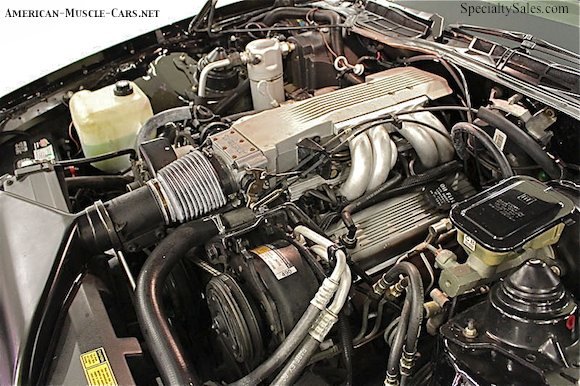
L03 305 V8 w/TBI, 1987-1995
TBI is short for Throttle Body Injection, and is a much simpler, cheaper-to-produce EFI system than the leading-edge (for the time) TPI. TPI used s separate timed injector for each intake port, while the TBI was set up more like a carburetor. It had a traditional intake manifold and in the place of a conventional carburetor was the EFI system with its injectors on one central location. It worked, and it certainly worked better than a carburetor, but it was never intended as a ‘performance’ engine, and it wasn’t. It ran well, got good mileage and was fairly clean at the tailpipe. GM used this engine in a wide range of passenger cars, trucks, vans and SUVs. It produced 170hp at 4400rpm and 255 lb/ft at 2400rpm.
The “Oddball” Chevy Small Block V8s – Gen I
262 CUBIC INCH (4.3-LITER) V8, 1975-1976
And you thought the 265 was the smallest Small Block? In 1975 Chevy was looking for ways to give buyers the power the craved with good fuel economy. Many things were tried. One of them was to shrink the Chevy small block V8 smaller than it had ever been before to give V8 power with far fewer cubic inches of displacement. At the time, the average engine in an American passenger car was a 350 V8. Downsizing had brought that down to the low-300s, but it still wasn’t enough. With a unique bore and stroke of 3.67” X 3.10”, the new engine displaced just 262 cubic inches (4299cc), and made 110hp at 3600rpm, and 133 lb/ft of torque. The 262 saw service in the 1975-76 Chevy Monza, ’75 Nova, and ’77 Pontiac Ventura. It was replaced in 1977 by the 305.
L30 305 V8 “Vortec 5000”, 1996-2003
Called the Vortec 5000 for it’s 5.0 liters of displacement and forming a part of the GM’s growing Vortec engine family, and was intended as a truck engine. It replaced the 4.8-liter Vortec 4800 in Chevy and GMC full-size trucks starting in 2003. It features a hydraulic cam with roller lifters, and high-flow, fast-turn Vortec heads, with a 9.1:1 compression ratio. While the L30 shares its approximate displacement with other 305 V8s, it has a unique bore and stroke at 3.7 inches (95mm) and 3.5 inches (88.4mm) respectively. ‘Normal’ 305s have a bore of 3.736 inches and a stroke of 3.48 inches. The L30 produced 220-230hp at 4600rpm and 285-290 lb/ft at 2800rpm.
267 CUBIC INCH (4.4-LITER) V8, 1979-1982
Another engine with a totally unique bore-stroke combo, this one used the 350’s (5.7L) crank with its 3.48-inch stroke, and gave it a 3.50-inch bore (shared with the 200 V6 introduced in 1978), to get to 267.8 cid (4,389cc). This creates a near-square bore-stroke ratio, fairly rare in modern times. It was introduced in the 1979 Camaro, their midsize G-body cars and the full-size B-bodies. The only carb was the 2-barrel Rochester Dualjet 210. Starting in 1980, electronic carb controls were added.
L99 262 CUBIC INCH (4.3-LITER) V8, 1996-1996
The 262 cid number is revisited, making this one of five GM engines that displaces 4.3 liters. Here again, we have a unique bore and stroke combination, different than any other Chevy Small Block V8. They started with a 305 block with its 3.736-inch (94.9mm) bore, gave it a 3.00-inch stroke (same as the 283 and 302) and voila! 262 cubes. This engine featured the Generation II block architecture, including reverse-flow cooling and looks just like the 5.7-liter LT1. The L99 was used in Chevy Caprice sedans, wagons, police cars from 1994-1996. It was not available in any other GM cars. The L99 produced 200hp and 245 pound-feet of torque.


